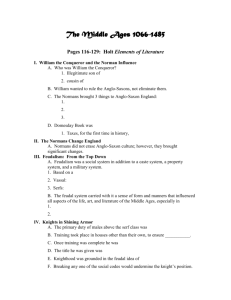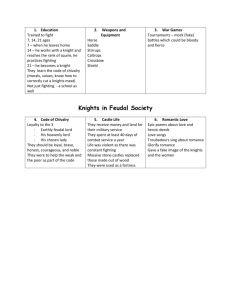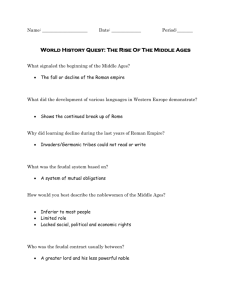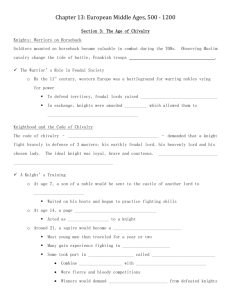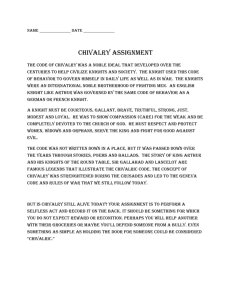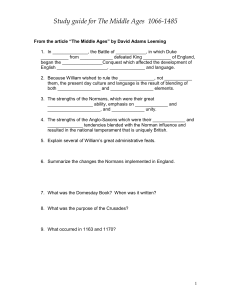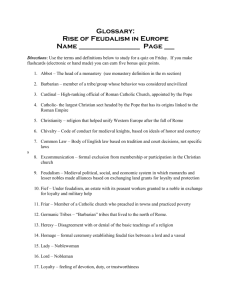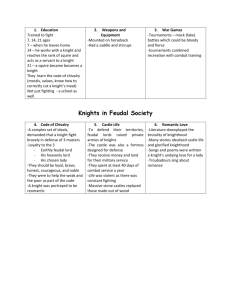European Middle Ages-Study Guide
advertisement
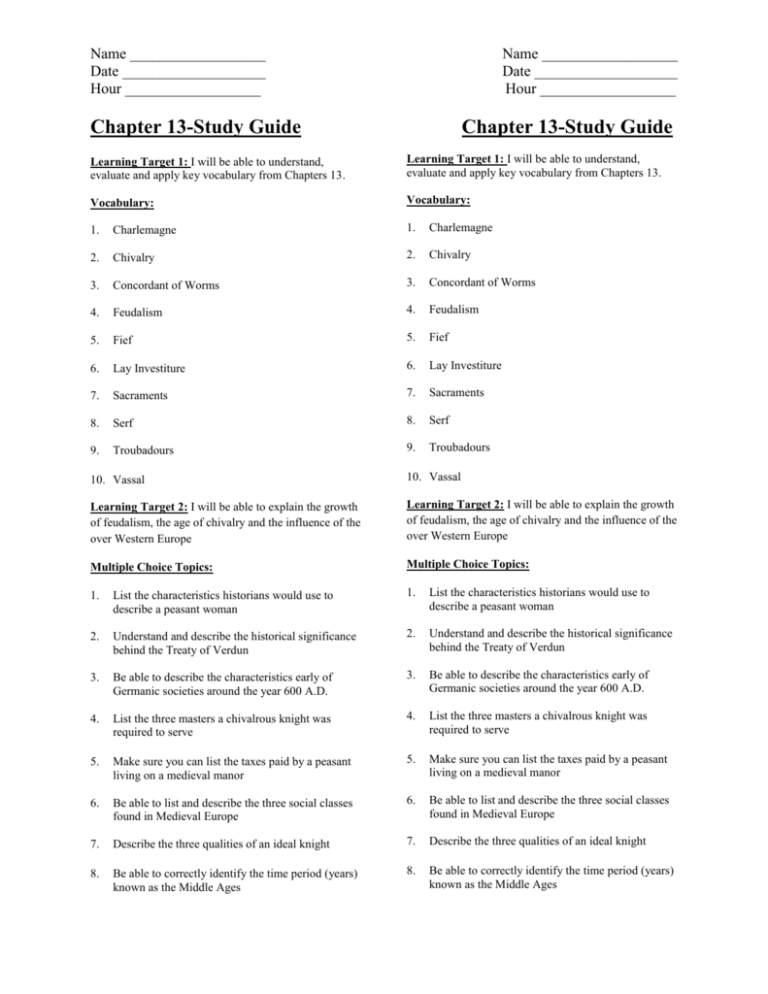
Name __________________ Date ___________________ Hour __________________ Name __________________ Date ___________________ Hour __________________ Chapter 13-Study Guide Chapter 13-Study Guide Learning Target 1: I will be able to understand, evaluate and apply key vocabulary from Chapters 13. Learning Target 1: I will be able to understand, evaluate and apply key vocabulary from Chapters 13. Vocabulary: Vocabulary: 1. Charlemagne 1. Charlemagne 2. Chivalry 2. Chivalry 3. Concordant of Worms 3. Concordant of Worms 4. Feudalism 4. Feudalism 5. Fief 5. Fief 6. Lay Investiture 6. Lay Investiture 7. Sacraments 7. Sacraments 8. Serf 8. Serf 9. Troubadours 9. Troubadours 10. Vassal 10. Vassal Learning Target 2: I will be able to explain the growth of feudalism, the age of chivalry and the influence of the over Western Europe Learning Target 2: I will be able to explain the growth of feudalism, the age of chivalry and the influence of the over Western Europe Multiple Choice Topics: Multiple Choice Topics: 1. List the characteristics historians would use to describe a peasant woman 1. List the characteristics historians would use to describe a peasant woman 2. Understand and describe the historical significance behind the Treaty of Verdun 2. Understand and describe the historical significance behind the Treaty of Verdun 3. Be able to describe the characteristics early of Germanic societies around the year 600 A.D. 3. Be able to describe the characteristics early of Germanic societies around the year 600 A.D. 4. List the three masters a chivalrous knight was required to serve 4. List the three masters a chivalrous knight was required to serve 5. Make sure you can list the taxes paid by a peasant living on a medieval manor 5. Make sure you can list the taxes paid by a peasant living on a medieval manor 6. Be able to list and describe the three social classes found in Medieval Europe 6. Be able to list and describe the three social classes found in Medieval Europe 7. Describe the three qualities of an ideal knight 7. Describe the three qualities of an ideal knight 8. Be able to correctly identify the time period (years) known as the Middle Ages 8. Be able to correctly identify the time period (years) known as the Middle Ages Name __________________ Date ___________________ Hour __________________ Name __________________ Date ___________________ Hour __________________ Chapter 13-Study Guide Chapter 13-Study Guide Short Answer Topics: Short Answer Topics: 1. You will be asked to describe the impact of Christianity on the Franks, early Christian leaders and their impact on daily rituals and the secular expansion of papal duties under Gregory I. a. Please think about the following when you answer: The year by which most Germanic people had converted to Christianity, The role of Benedict and Scholastica in establishing new customs, The roles of monks and nuns, The purpose of illuminated manuscripts, and the use of church funds for secular purposes under Pope Gregory I 1. You will be asked to describe the impact of Christianity on the Franks, early Christian leaders and their impact on daily rituals and the secular expansion of papal duties under Gregory I. a. Please think about the following when you answer: The year by which most Germanic people had converted to Christianity, The role of Benedict and Scholastica in establishing new customs, The roles of monks and nuns, The purpose of illuminated manuscripts, and the use of church funds for secular purposes under Pope Gregory I 2. You will be asked to examine the goals and impact of the three invading groups we talked about in section two who occupied Western Europe a. Please think about the following when you answer: The origins of the Vikings, important figure(s) and roles they served within their society, The origins of the Magyars, the places they attacked and how they impacted other societies, The origins of the Muslims, their early goals and the impact of the Magyars and how they impacted local rulers 2. You will be asked to examine the goals and impact of the three invading groups we talked about in section two who occupied Western Europe a. Please think about the following when you answer: The origins of the Vikings, important figure(s) and roles they served within their society, The origins of the Magyars, the places they attacked and how they impacted other societies, The origins of the Muslims, their early goals and the impact of the Magyars and how they impacted local rulers 3. You will be asked to describe the mutually beneficial relationship between a knight and his feudal lord, the process of becoming a knight and how the code of chivalry guided a knight on his journey. a. Please think about The obligations owed by the knight to the feudal lord and how he was compensated, The process of becoming a knight (by age and responsibility), The Code of Chivalry and the qualities of an ideal knight 3. You will be asked to describe the mutually beneficial relationship between a knight and his feudal lord, the process of becoming a knight and how the code of chivalry guided a knight on his journey. a. Please think about The obligations owed by the knight to the feudal lord and how he was compensated, The process of becoming a knight (by age and responsibility), The Code of Chivalry and the qualities of an ideal knight understand the shifts from nomadic tribes to complex civilizations. Name __________________ Date ___________________ Hour __________________ Name __________________ Date ___________________ Hour __________________ Chapter 13-Study Guide Learning Target 3: I will be able to summarize, examine and evaluate historical maps, data, charts, graphs, photos, audio, clips and video footage to explain and understand the growth of feudalism, the age of chivalry and the influence of the over Western Europe 1. You will be given a blank feudal pyramid and asked four questions about its levels of hierarchy and the roles of each feudal group 2. You will be given an image of a medieval manor and asked comparative questions designed to showcase your understanding of the roles and responsibilities of each feudal group Learning Target 4: I will be able to summarize, evaluate and construct connections (to myself, the world and/or other topics we have studied) using a variety of primary and secondary documents. 1. You will be given a primary source document designed to draw out your inference regarding the organization and division of labor on a medieval manor Chapter 13-Study Guide Learning Target 3: I will be able to summarize, examine and evaluate historical maps, data, charts, graphs, photos, audio, clips and video footage to explain and understand the growth of feudalism, the age of chivalry and the influence of the over Western Europe 1. You will be given a blank feudal pyramid and asked four questions about its levels of hierarchy and the roles of each feudal group 2. You will be given an image of a medieval manor and asked comparative questions designed to showcase your understanding of the roles and responsibilities of each feudal group Learning Target 4: I will be able to summarize, evaluate and construct connections (to myself, the world and/or other topics we have studied) using a variety of primary and secondary documents. 1. You will be given a primary source document designed to draw out your inference regarding the organization and division of labor on a medieval manor
